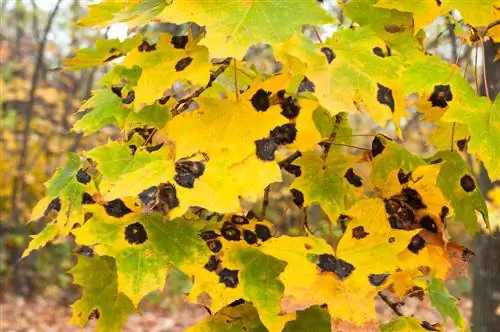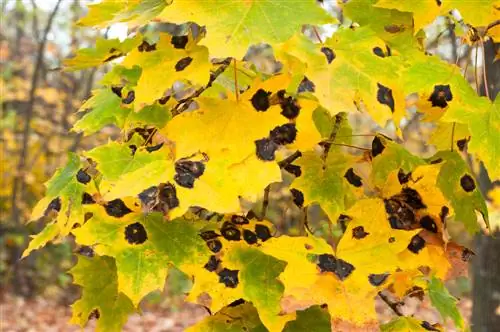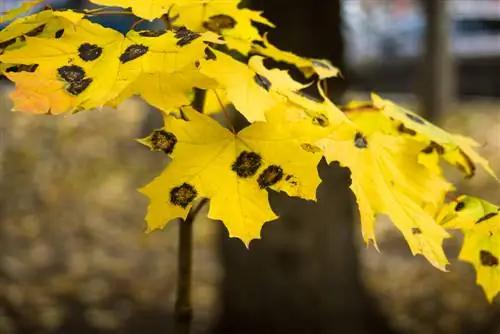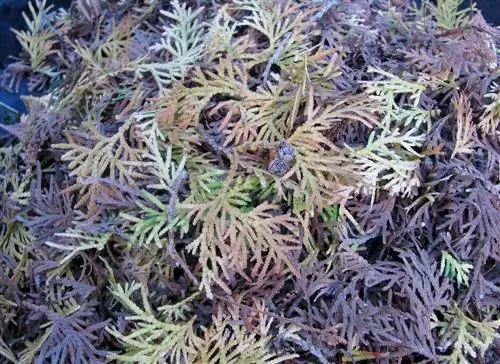- Author admin [email protected].
- Public 2023-12-16 16:46.
- Last modified 2025-06-01 06:02.
A maple tree is not spared from tree diseases. Treacherous pathogens target the beautiful leaves, the distinctive bark or the shoots. Affected gardeners are not powerless against the damage. This guide lists typical symptoms and natural control methods. This is how you take the fear out of common tree diseases on maple trees.

What diseases commonly occur in maple and how to treat them?
Typical maple diseases include maple scab, red pustule fungi and verticillium wilt. In the case of maple scab, affected leaves should be disposed of, in the case of red pustule fungi, pruning into he althy wood is necessary and in the case of verticillium wilt, clearing and soil replacement is recommended.
Maple wrinkled scab - recognize and treat signs
One of the most common tree diseases on maple trees is aptly named after the tree. The pathogens that cause maple scab have specialized in the genus. Due to the unmistakable damage, the infection is also known as tar spot disease. How to diagnose and combat fungal infestation:
- Glossy black, yellow-edged, slightly raised spots on living leaves
- Premature leaf fall in summer
- Combat: collect all leaves in autumn, burn them or dispose of them in household waste
By carefully removing the leaves and interrupting the development cycle of the fungal spores, your maple tree will be spared from the disease the following year.
Identifying and combating red pustule fungi - this is how it works
The obvious fruiting bodies only reveal one of the most common tree diseases in autumn and winter. Long before that, the pathogens of red pustule disease had established themselves in a maple tree that had been weakened by errors in care. This is how you track down fungal spores:
- Withering leaves and limp shoots in spring and summer
- Unusual bark discoloration with subsequent cancerous growths
- In the cold season, pinhead-sized, vermilion-red fruiting bodies emerge
The pathogens have so far proven to be resistant to known fungicides. In field tests, tree disease experts found that cutting back into he althy wood deprives fungal spores of their livelihood. The best time for the measure is on a mild, dry day between the beginning of September and mid-October.
Verticillium wilt - recognize symptoms and act correctly
A maple tree is the most important host plant for the fungi of the genus Verticillium. Fatally, the pathogens penetrate the pathways through the soil, blocking the supply of water and nutrients, so that the affected maple tree is doomed to perish. Since the disease is massively contagious, we recommend immediate clearing and subsequent soil replacement. You can recognize verticillium wilt by these symptoms:
- Branches sprout normally in spring and show wilted leaves out of the blue
- Previously firm, green leaves become pale green and limp
- Ring-shaped, brown discolorations can be seen in thicker branches that have been cut open
Typical of verticillium wilt is the partial appearance of the symptoms mentioned. While there are no signs in one region of the crown, other areas are gradually dying off. This spread in places makes it easy to distinguish the disease from frost damage, drought stress or waterlogging.
Tip
If you are worried about brown leaves on the maple tree, it is usually not a disease. If the brown discoloration begins on the edges of the leaves, the tree or shrub is suffering from a location problem or care errors. A windswept location causes the damage just as often as a substrate that is too wet or too dry.






